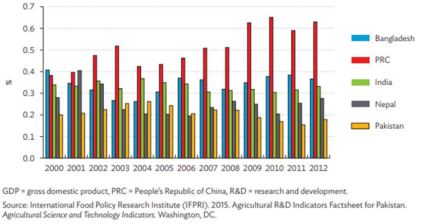Rice Production, Quality, and Nutrition: A Comprehensive Review on Challenges, Opportunities, and Global Perspectives
Keywords:
Nutritional Enhancement, Rice Bio fortification, Basmati Rice, Price volatility, Micronutrient DeficienciesAbstract
Improving rice's quality can significantly raise its worth for growers and consumers alike. This comprehensive review addresses the multifaceted aspects of rice, the staple food for over half the global population, and delves into the challenges and opportunities associated with its production, quality, and nutritional enhancement. It highlights the pervasive issue of micronutrient malnutrition affecting billions and the pressing need for sustainable solutions. The intricate connection between rice production and environmental changes, coupled with the looming challenges of climate change, is thoroughly explored. The paper emphasizes the role of quality control throughout the rice value chain, shedding light on the diverse factors influencing rice preferences and the economic implications of premium varieties. Micronutrient deficiencies, including iron, zinc, and selenium, pose significant health risks, particularly in underdeveloped regions. The review underscores the potential of rice bio-fortification as a promising strategy for long-term nutritional security. It draws attention to the disparities in approaches between developed and economically challenged nations, advocating for cost-effective methods to enhance the nutritional content of widely consumed cereals. The analysis of the global rice production landscape, with a focus on Thailand's premium varieties and India's Basmati rice, unveils the intricate interplay of market dynamics, policies, and consumer preferences. The paper provides insights into the challenges faced by the Basmati rice industry in Pakistan, attributing stagnation to inadequate research and development investments and a lack of policy commitment. The historical evolution of rice varieties and the impact of ecological and socioeconomic factors on rice types and grades are discussed. The distinctions between Indica and Japonica rice varieties, along with the varying amylose content, highlight the complexity of rice diversity on a global scale. Furthermore, the review examines contemporary challenges in Asian rice farming, emphasizing the importance of management techniques and selective breeding in improving overall quality. It delves into the complexities of rice grain quality, including the influence of environmental factors, post-harvest treatments, and economic considerations in the rice trade. In conclusion, this comprehensive review provides a nuanced understanding of the intricate world of rice production, addressing issues ranging from nutritional security to market dynamics. It serves as a valuable resource for policymakers, researchers, and stakeholders seeking to navigate the complexities of rice cultivation in a changing global landscape.
References
M. Said and M. Mursal Ibrahim, “A Comprehensive Overview of Challenges and Prospects in Large-Scale Rice Production Among Farmers in Jawhar, Middle Shabelle, Somalia”, doi: 10.26717/BJSTR.2023.52.008321.
K. Jabran et al., “Mulching Improves Water Productivity, Yield and Quality of Fine Rice under Water-saving Rice Production Systems,” J. Agron. Crop Sci., vol. 201, no. 5, pp. 389–400, Oct. 2015, doi: 10.1111/JAC.12099.
Y. Jiang, W. Tao, W. Zhang, Z. Wang, and J. Yang, “Wetting alternating with partial drying during grain filling increases lysine biosynthesis in inferior rice grain,” Crop J., 2023, doi: 10.1016/j.cj.2023.11.008.
N. K. Fukagawa and L. H. Ziska, “Rice: Importance for Global Nutrition,” J. Nutr. Sci. Vitaminol. (Tokyo)., vol. 65, no. Supplement, pp. S2–S3, Oct. 2019, doi: 10.3177/JNSV.65.S2.
M. Ishfaq et al., “Influence of nitrogen management regimes on milling recovery and grain quality of aromatic rice in different rice production systems,” Agronomy, vol. 10, no. 11, Nov. 2020, doi: 10.3390/AGRONOMY10111841.
M. Wissuwa, A. M. Ismail, and R. D. Graham, “Rice grain zinc concentrations as affected by genotype, native soil-zinc availability, and zinc fertilization,” Plant Soil, vol. 306, no. 1–2, pp. 37–48, Apr. 2008, doi: 10.1007/S11104-007-9368-4/METRICS.
T. Y. Wu, W. Gruissem, and N. K. Bhullar, “Targeting intracellular transport combined with efficient uptake and storage significantly increases grain iron and zinc levels in rice,” Plant Biotechnol. J., vol. 17, no. 1, pp. 9–20, Jan. 2019, doi: 10.1111/PBI.12943.
K. R. Trijatmiko et al., “Biofortified indica rice attains iron and zinc nutrition dietary targets in the field,” Sci. Reports 2016 61, vol. 6, no. 1, pp. 1–13, Jan. 2016, doi: 10.1038/srep19792.
J. L. Slavin, M. C. Martini, D. R. Jacobs, and L. Marquart, “Plausible mechanisms for the protectiveness of whole grains,” Am. J. Clin. Nutr., vol. 70, no. 3, pp. 459S-463S, Sep. 1999, doi: 10.1093/AJCN/70.3.459S.
T. Yang et al., “The impacts of post-anthesis warming on grain yield and quality of double-cropping high-quality indica rice in Jiangxi Province, China,” Eur. J. Agron., vol. 139, Sep. 2022, doi: 10.1016/j.eja.2022.126551.
“View of Improving Rice Yield Through Insufficient Water.” Accessed: Feb. 22, 2024. [Online]. Available: https://journal.50sea.com/index.php/IJASD/article/view/425/504
R. W. Simmons, P. Pongsakul, D. Saiyasitpanich, and S. Klinphoklap, “Elevated levels of ladmium and zinc in paddy soils and elevated levels of cadmium in rice grain downstream of a zinc mineralized area in Thailand: Implications for public health,” Environ. Geochem. Health, vol. 27, no. 5–6, pp. 501–511, Oct. 2005, doi: 10.1007/S10653-005-7857-Z/METRICS.
V. Singh, A. K. Singh, T. Mohapatra, S. Gopala Krishnan, and R. K. Ellur, “Pusa Basmati 1121 – a rice variety with exceptional kernel elongation and volume expansion after cooking,” Rice, vol. 11, no. 1, pp. 1–10, Dec. 2018, doi: 10.1186/S12284-018-0213-6/TABLES/3.
W. Seetanun and S. K. De Datta, “Grain Yield, Milling Quality, and Seed Viability of Rice as Influenced by Time of Nitrogen Application and Time of Harvest1,” Agron. J., vol. 65, no. 3, pp. 390–394, May 1973, doi: 10.2134/AGRONJ1973.00021962006500030012X.
C. Saenchai, C. Prom-u-thai, S. Jamjod, B. Dell, and B. Rerkasem, “Genotypic variation in milling depression of iron and zinc concentration in rice grain,” Plant Soil, vol. 361, no. 1–2, pp. 271–278, Nov. 2012, doi: 10.1007/S11104-012-1228-1/METRICS.
C. Ros, C. Ros, R. W. Bell, and P. F. White, “Effect of seed phosphorus and soil phosphorus applications on early growth of rice (Oryza sativa L.) cv. IR66,” Soil Sci. Plant Nutr., vol. 43, no. 3, pp. 499–509, Sep. 1997, doi: 10.1080/00380768.1997.10414777.
“Consumer preferences for rice in Africa. | Realizing Africa’s rice promise.” Accessed: Jan. 11, 2024. [Online]. Available: https://www.cabidigitallibrary.org/doi/10.1079/9781845938123.0294
T. Reardon et al., “The quiet revolution in Asia’s rice value chains,” Ann. N. Y. Acad. Sci., vol. 1331, no. 1, pp. 106–118, Dec. 2014, doi: 10.1111/NYAS.12391.
M. S. Rahman, M. A. M. Miah, H. M. Khaled, A. Islam, and G. M. Panaullah, “Arsenic Concentrations in Groundwater, Soils, and Irrigated Rice in Southwestern Bangladesh,” Commun. Soil Sci. Plant Anal., vol. 41, no. 16, pp. 1889–1895, 2010, doi: 10.1080/00103624.2010.495800.
T. Pusadee, A. Wongtamee, B. Rerkasem, K. M. Olsen, and S. Jamjod, “Farmers Drive Genetic Diversity of Thai Purple Rice (Oryza sativa L.) Landraces,” Econ. Bot., vol. 73, no. 1, pp. 76–85, Mar. 2019, doi: 10.1007/S12231-018-9436-0/METRICS.
G. Aluko, C. Martinez, J. Tohme, C. Castano, C. Bergman, and J. H. Oard, “QTL mapping of grain quality traits from the interspecific cross Oryza sativa x O. glaberrima,” Theor. Appl. Genet., vol. 109, no. 3, pp. 630–639, Apr. 2004, doi: 10.1007/S00122-004-1668-Y/METRICS.
M. B. Zimmermann and R. F. Hurrell, “Improving iron, zinc and vitamin A nutrition through plant biotechnology,” Curr. Opin. Biotechnol., vol. 13, no. 2, pp. 142–145, Apr. 2002, doi: 10.1016/S0958-1669(02)00304-X.
K. Zhao, X. Liu, J. Xu, and H. M. Selim, “Heavy metal contaminations in a soil–rice system: Identification of spatial dependence in relation to soil properties of paddy fields,” J. Hazard. Mater., vol. 181, no. 1–3, pp. 778–787, Sep. 2010, doi: 10.1016/J.JHAZMAT.2010.05.081.
L. J. Unnevehr, “Consumer Demand for Rice Grain Quality and Returns to Research for Quality Improvement in Southeast Asia,” Am. J. Agric. Econ., vol. 68, no. 3, pp. 634–641, Aug. 1986, doi: 10.2307/1241547.
“Plantwise Knowledge Bank.” Accessed: Jan. 11, 2024. [Online]. Available: https://plantwiseplusknowledgebank.org/doi/10.1079/pwkb.20167800087
N. A. Slaton, J. Wilson, S. Ntamatungiro, R. J. Norman, and D. L. Boothe, “Evaluation of Zinc Seed Treatments for Rice,” Agron. J., vol. 93, no. 1, pp. 152–157, Jan. 2001, doi: 10.2134/AGRONJ2001.931152X.
A. Sriprachote, P. Kanyawongha, K. Ochiai, and T. Matoh, “Current situation of cadmium-polluted paddy soil, rice and soybean in the Mae Sot District, Tak Province, Thailand,” Soil Sci. Plant Nutr., vol. 58, no. 3, pp. 349–359, Jan. 2012, doi: 10.1080/00380768.2012.686435.
T. J. Siebenmorgen, R. C. Bautista, and P. A. Counce, “Optimal Harvest Moisture Contents for Maximizing Milling Quality of Long- and Medium-Grain Rice Cultivars,” Appl. Eng. Agric., vol. 23, no. 4, pp. 517–527, 2007, doi: 10.13031/2013.23476.
R. W. Simmons, P. Pongsakul, R. L. Chaney, D. Saiyasitpanich, S. Klinphoklap, and W. Nobuntou, “The relative exclusion of zinc and iron from rice grain in relation to rice grain cadmium as compared to soybean: Implications for human health,” Plant Soil, vol. 257, no. 1, pp. 163–170, Nov. 2003, doi: 10.1023/A:1026242811667/METRICS.
B. Rerkasem, “The Rice Value Chain: a Case Study of Thai Rice,” ASR C. J. Soc. Sci. Humanit., vol. 4, no. 1, 2017, doi: 10.12982/CMUJASR.2017.0001.
S. Rodrigo, O. Santamaria, L. Perez-Izquierdo, and M. J. Poblaciones, “Arsenic and selenium levels in rice fields from south-west of Spain: influence of the years of monoculture,” https://pse.agriculturejournals.cz/doi/10.17221/105/2017-PSE.html, vol. 63, no. 4, pp. 184–188, 2017, doi: 10.17221/105/2017-PSE.
H. Ram et al., “Biofortification of wheat, rice and common bean by applying foliar zinc fertilizer along with pesticides in seven countries,” Plant Soil, vol. 403, no. 1–2, pp. 389–401, Jun. 2016, doi: 10.1007/S11104-016-2815-3/METRICS.
N. Zahra, M. B. Hafeez, A. Nawaz, and M. Farooq, “Rice production systems and grain quality,” J. Cereal Sci., vol. 105, p. 103463, May 2022, doi: 10.1016/J.JCS.2022.103463.
O. S. Sakariyawo, O. E. Oyedeji, and A. A. Soretire, “Effect of iron deficiency on the growth, development and grain yield of some selected upland rice genotypes in the rainforest,” J. Plant Nutr., vol. 43, no. 6, pp. 851–863, Apr. 2020, doi: 10.1080/01904167.2020.1711936.
S. Ahmed, E. Humphreys, M. Salim, and B. S. Chauhan, “Growth, yield and nitrogen use efficiency of dry-seeded rice as influenced by nitrogen and seed rates in Bangladesh,” F. Crop. Res., vol. 186, pp. 18–31, Feb. 2016, doi: 10.1016/j.fcr.2015.11.001.
A. Development Bank, “Investment in Research and Development for Basmati Rice in Pakistan,” 2018, Accessed: Feb. 16, 2024. [Online]. Available: www.adb.org
M. A. Rahman, H. Hasegawa, M. M. Rahman, M. A. Rahman, and M. A. M. Miah, “Accumulation of arsenic in tissues of rice plant (Oryza sativa L.) and its distribution in fractions of rice grain,” Chemosphere, vol. 69, no. 6, pp. 942–948, Oct. 2007, doi: 10.1016/J.CHEMOSPHERE.2007.05.044.
C. Prom-U-Thai, B. Rerkasem, A. Yazici, and I. Cakmak, “Zinc priming promotes seed germination and seedling vigor of rice,” J. Plant Nutr. Soil Sci., vol. 175, no. 3, pp. 482–488, Jun. 2012, doi: 10.1002/JPLN.201100332.
M. J. Rahman, P. Li, and R. Hasan, “Determinants of the Adoption of Integrated Reports: An International Investigation,” Indones. J. Sustain. Account. Manag., vol. 4, no. 1, p. 103, Jun. 2020, doi: 10.28992/IJSAM.V4I1.209.
“Rice production systems and grain quality - ScienceDirect.” Accessed: Feb. 16, 2024. [Online]. Available: https://www.sciencedirect.com/science/article/abs/pii/S0733521022000522
A. Phapumma, T. Monkham, S. Chankaew, W. Kaewpradit, P. Harakotr, and J. Sanitchon, “Characterization of indigenous upland rice varieties for high yield potential and grain quality characters under rainfed conditions in Thailand,” Ann. Agric. Sci., vol. 65, no. 2, pp. 179–187, Dec. 2020, doi: 10.1016/j.aoas.2020.09.004.
F. Dou, J. Soriano, R. E. Tabien, and K. Chen, “Soil Texture and Cultivar Effects on Rice (Oryza sativa, L.) Grain Yield, Yield Components and Water Productivity in Three Water Regimes,” PLoS One, vol. 11, no. 3, Mar. 2016, doi: 10.1371/JOURNAL.PONE.0150549.
A. Mehmood, A. Tanveer, M. M. Javed, M. A. Nadeem, M. Naeem, and T. Abbas, “Estimation of economic threshold level of alligator weed (Alternanthera philoxeroides (Mart.) Griseb.) to Tackle Grain quality and yield Losses in Rice,” Arch. Agron. Soil Sci., vol. 64, no. 2, pp. 208–218, Jan. 2018, doi: 10.1080/03650340.2017.1340643.
S. T. Sadati Valojai, Y. Niknejad, H. Fallah Amoli, and D. Barari Tari, “Response of rice yield and quality to nano-fertilizers in comparison with conventional fertilizers,” J. Plant Nutr., vol. 44, no. 13, pp. 1971–1981, 2021, doi: 10.1080/01904167.2021.1884701.
M. Farooq, K. H. M. Siddique, H. Rehman, T. Aziz, D. J. Lee, and A. Wahid, “Rice direct seeding: Experiences, challenges and opportunities,” Soil Tillage Res., vol. 111, no. 2, pp. 87–98, Jan. 2011, doi: 10.1016/j.still.2010.10.008.




